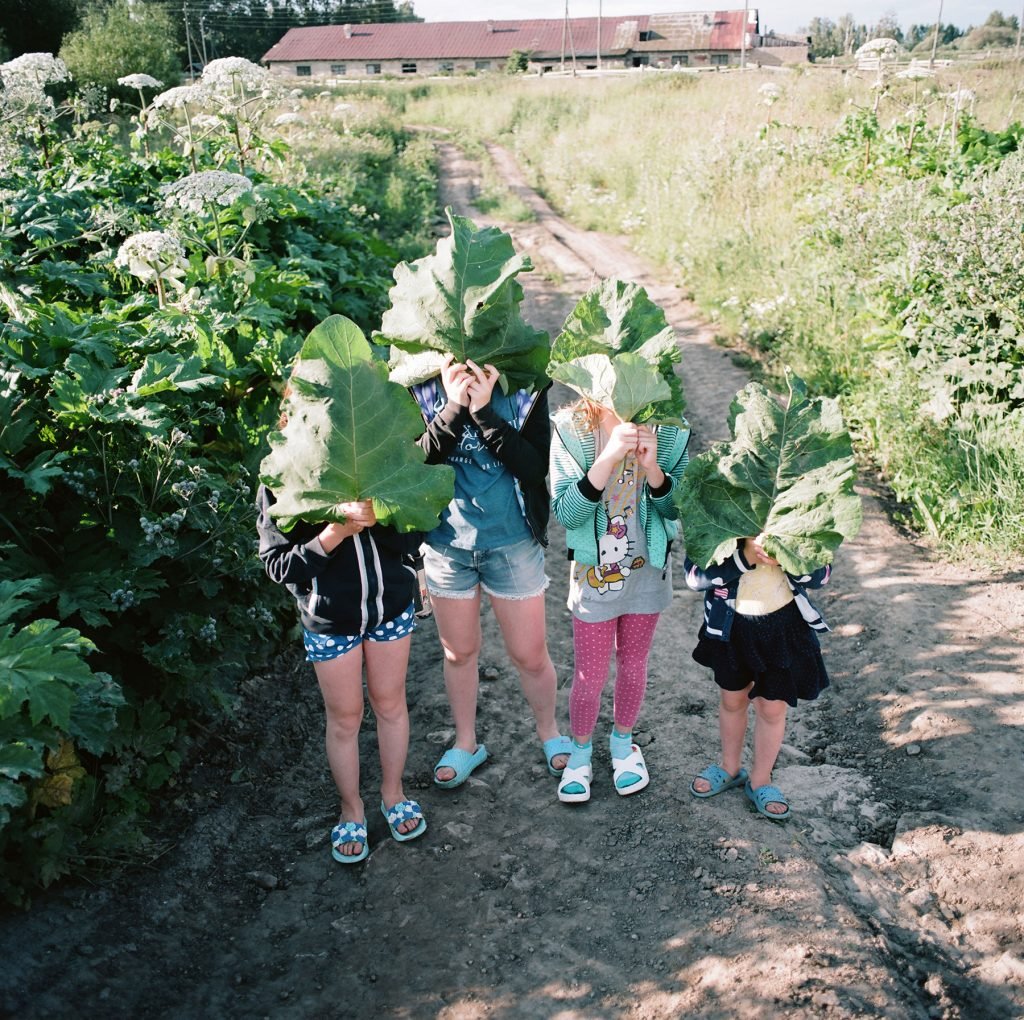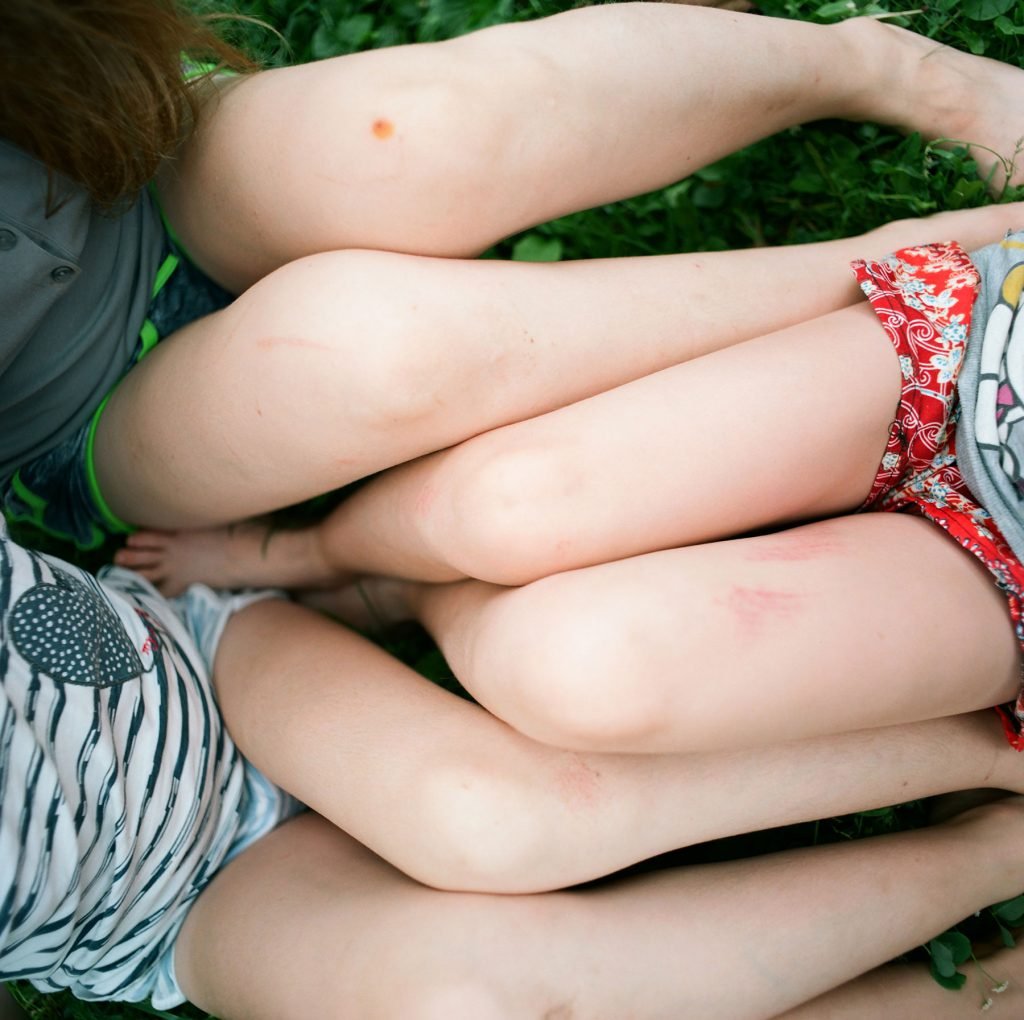I went to the village where I was born and raised, with the aim of coming to terms with my experiences that had tormented me from my teens. For many years I lived in fear that at any moment the floor could fall from under me, and the total distrust of people and the world turned me into a prisoner of my own trauma.
Four of my nieces spent holidays with my grandparents in the village. I couldn’t tear myself away from them, watching how they communicate with each other, how they learn to understand their desires and express their thoughts, how free and careless they are and how easily and fearlessly they explore the world. I recalled that once I too could be open to everything and not be afraid. Gradually, plunging into the world of girls, I stopped focusing on my internal struggle, shifting the vector of my attention outward, to the vortex of childhood that I did not know, which I did not have and which I suddenly began to attain.
Thus began the reconstruction of my memory, the formation of new images of youth, the living of an alternative experience of a childhood without oppression and hierarchy.
So began the return of innocence stolen from me by rape 18 years ago.
Iva Kontic: How did your video work Returning Innocence came about?
Yana Pirozhok: Initially, I planned to shoot documentary observations. In the process, the distance between me and the girls rapidly faded, they became interested in the shooting and I did not interfere with this. I handed them the camera and gave them complete freedom of action. They agreed among themselves on who would be shooting, handing me back the camera whenever they lost interest in it. I really liked this natural creative process and did not want to impose any specific scenario or scheme.
IK: The video embraces the low quality aesthetics, the footage is raw and you often use rough cuts, split screen and noise in terms of both, sound and image. Can you tell me about your intentions behind such an approach to filmmaking?
YP: The important thing to me was to create a link with the time of the traumatic event which was in 1997. Therefore, the choice of what video camera to shoot with did not take me a long time, it was a fairly obvious decision for me: an old cassette video camera. And I consciously abandoned the standards of cinematic pictures and sound, leaving just “bare life”, reinforcing anti-cinematography by abandoning the classical methods of editing and linearity of logical narration.
I also ruled out staging and screenwriting, giving the girls the opportunity to film however they wanted, depriving myself of the possibility of any directing. As for the film bugs in the frame, those are real bugs due to not good enough digitization and the poor quality of supported cassettes. I bought them from some online ad, I didn’t have much money then, so I had to trust and choose the cheapest ones, and when digitizing it turned out that there was still a recording layer on several tapes and some part of the recorded material simply disappeared. But I decided not to cut these bugs. I was looking at the footage and when I saw a moment where the image suddenly breaks and a piece of some movie that does not belong to the general context comes out through the blue screen, I panicked terribly – what is it, where is it from? Where is the rest of the material? What now? But then I realized that this is an excellent visualization of the chaos that breaks into a person’s life at the time of trauma. Habitual life is suddenly interrupted and there is no understanding of what is happening and complete disorientation. It’s impossible to put the pieces together and keep life under control, sometimes such sudden bugs appear that divide life into before and after.
IK: For you, in which way the subject of trauma reaches, or should reach the viewer?
YP: The trauma of sexual violence at a young age is primarily a gross invasion of innocence and its destruction. Innocence is literally the absence of guilt, the absence of negative experience, the absence of oppression. I deliberately do not focus on the violence itself and mention it as a fact of my life only in the text at the very end. In the film we do not see trauma, we see the absence of trauma. We find ourselves in innocence itself, inside it, we see the world of the child.
This was important for me: to experience the absence of trauma. Only through visual bugs and noise in the image can the viewer feel discomfort, feel the fragility of childhood.
In the series of photographs, I allow myself to represent innocence through the prism of my traumatic experience, focusing on color, images and playing with distance, which creates an atmosphere of a coming danger or threat and increases the vulnerability of innocence. I wanted to show the fragility of the world of a child and the fragility of innocence, to indicate the importance of protecting it and keeping it safe.
IK: Besides the video, the art project Returning Innocence includes a series of photographs. How the two outputs dialogue with each other in this work?
YP: Photos and videos work in a collision, in contrast. The video is the point of view of a child, the subjectivity of childhood. Photographs are the observer optics and create an atmosphere of anticipation of anxiety. I planned to make an exhibition where the photographs would play the role of a guide leading the viewer through an atmosphere of impending anxiety, and the film would accordingly exit the state of anxiety through gaining a new experience of an alternative childhood without oppression and hierarchy.
IK: Your subjects are young girls, children. Their bodies are shown with certain intimacy and directness, putting us in the condition of close observers. Do you believe that art can escape the ambivalence of this type of iconography? Is there an ethical risk for misrepresentation?
YP: I thought about this question for a long time. Can the viewer have a different interpretation of my statement? Is there an ethical risk in portraying children? The answer came from life. When I first published photos of this series in a Russian publication negative comments began to appear, in which people accused me of exploiting child images and denigrating them. This upset me very much and I even refused to publish the project anywhere else and for several months did not even want to think about it. I was shocked that some people had a negative reading of my story. I think it is difficult to avoid ambivalence. Or even impossible. People have a different cultural background, which provokes an infinite number of readings of any kind of art. Another question is the responsibility and sincerity of the author themselves. For me, the importance of the project as a unique bright experience, not only in my life, but also the life of my nieces is obvious. It was not only my rehabilitation through gaining a childhood that I did not have, but also the formation of friendship between a child and an adult, which helped to break the boundaries of the hierarchy and create new relationships based on trust and love. In my childhood there was no such adult friend and that only increased the scale of my distrust of the world.
IK: What is the role of art, if there should be any, in addressing the topic of sexual violence?
YP: Our society, and I am now talking about my country, Russia, is at the stage of denying the problem of sexual violence, no one wants to know that this is happening. And if a resonance suddenly arises, then society splits into those who protect the victims of violence, and those who believe that the victims themselves are to blame. And the latter generally outnumber the former. This is a monstrous situation of lack of dialogue and empathy.
I myself dared to talk about my trauma of sexual violence only now at 33 years of age. And all these years I have been in fear that they will condemn me. It is very important now to acknowledge this problem for the formation of a healthy dialogue and discourse in society, which will make it possible in the future to respond more quickly to such crimes and provide the basis for the humanization of society. Art gives me the opportunity of reflection and the experience of gaining freedom.
Yana Pirozhok (b. 1986) is a documentary photographer and visual artist from Russia. She works with photography and video art and her projects explore the concepts of psychological trauma.











